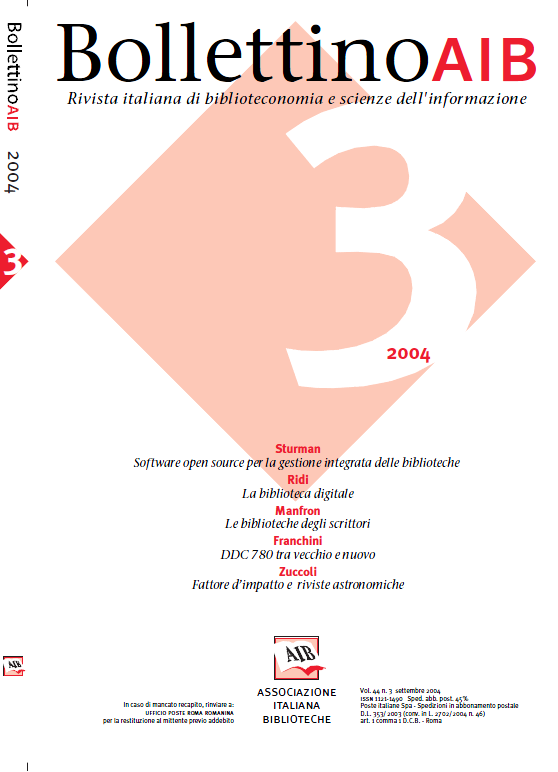Authors' libraries
Main Article Content
Abstract
Authors' libraries preserved and kept in public libraries are viewed as special collections because they form units that are separate from general collections since they often include documents that are different in nature and typology and form a significant and consistent separate set. Furthermore, they are destined mostly to specific users such as specialists, experts and scholars.
In some cases these collections are kept in public libraries together with the writer's records and papers and this makes it easier to detect links and cross-references exististing between papers and volumes, to highlight their context, to interpret, describe and give a proper value to all documents according to their nature, typology, production material and technique. All this is possible also in the light of the ties that unite these documents thus forming an organic set, that is a "unitary document that is not to be altered". The books chosen, red, received by or "inflicted" upon the writer nat the time when he was given them, have somehow changed their status.
They no longer are publications, they have become personal papers and consequently the cataloguing procedure will also have to include the accurate description of the traces left on them time after time (i.e. notes and entries, corrections, addenda, underlinings, marginal notes, and other reading marks or signs), of possible ownership markings (i.e. ex libris, ex dono, handwritten dedications, special bindings), of inserts kept between the pages (handwritten notes, clippings, letters and cards, photos, etc.), thus providing to historians and philologists useful elements to trace back the so-called "author's way of reading" the texts, as well as the intellectual and socio-economic context within which the writer's life and work unravelled.
The descriptive and cataloguing procedures of the archive-library of an author should be made with the aim of overcoming the gap between the bibliographic data-bank and the archival description, and bearing in mind what envisaged by the ISAAR (CPF) standard so as to provide relevant "context-related" information.
Among the various problems relating to authors' library management we should also list a number of adequate preservation activities. There often are volumes representing rare and valuable evidences of the most important and representative production of contemporary publishing, such as plaquettes , artistic books, first editions with original bindings, volumes with jackets and publishing wrappers, bookseller's orders and forms, purchasing receipts, advertising and editorial cards.
Readers' access granted to these books, as well as to the autographic documents that are frequently kept between their pages, may entail the need for public libraries to adopt security and information procedures that are normally adopted when handling and managing private archives and records. This means that readers and users in general shall have to comply with what envisaged by the laws regulating authors' rights and privacy rights (should authors or their successors still be alive).
In some cases these collections are kept in public libraries together with the writer's records and papers and this makes it easier to detect links and cross-references exististing between papers and volumes, to highlight their context, to interpret, describe and give a proper value to all documents according to their nature, typology, production material and technique. All this is possible also in the light of the ties that unite these documents thus forming an organic set, that is a "unitary document that is not to be altered". The books chosen, red, received by or "inflicted" upon the writer nat the time when he was given them, have somehow changed their status.
They no longer are publications, they have become personal papers and consequently the cataloguing procedure will also have to include the accurate description of the traces left on them time after time (i.e. notes and entries, corrections, addenda, underlinings, marginal notes, and other reading marks or signs), of possible ownership markings (i.e. ex libris, ex dono, handwritten dedications, special bindings), of inserts kept between the pages (handwritten notes, clippings, letters and cards, photos, etc.), thus providing to historians and philologists useful elements to trace back the so-called "author's way of reading" the texts, as well as the intellectual and socio-economic context within which the writer's life and work unravelled.
The descriptive and cataloguing procedures of the archive-library of an author should be made with the aim of overcoming the gap between the bibliographic data-bank and the archival description, and bearing in mind what envisaged by the ISAAR (CPF) standard so as to provide relevant "context-related" information.
Among the various problems relating to authors' library management we should also list a number of adequate preservation activities. There often are volumes representing rare and valuable evidences of the most important and representative production of contemporary publishing, such as plaquettes , artistic books, first editions with original bindings, volumes with jackets and publishing wrappers, bookseller's orders and forms, purchasing receipts, advertising and editorial cards.
Readers' access granted to these books, as well as to the autographic documents that are frequently kept between their pages, may entail the need for public libraries to adopt security and information procedures that are normally adopted when handling and managing private archives and records. This means that readers and users in general shall have to comply with what envisaged by the laws regulating authors' rights and privacy rights (should authors or their successors still be alive).
Article Details
Section
Articles

This work is licensed under a Creative Commons Attribution-ShareAlike 4.0 International License.
